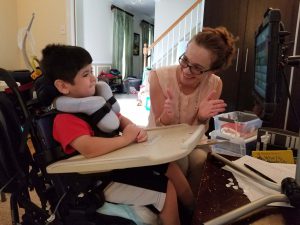 One of the more powerful ways I’ve found to encourage Joey’s communication on the eye gaze device is to read wordless picture books that still have a substantial storyline- or at least books with limited words on each page. These books are great for all kindergarteners because they allow a child to enjoy a full, exciting story, while also using their pre-reading skills to read the book independently.
One of the more powerful ways I’ve found to encourage Joey’s communication on the eye gaze device is to read wordless picture books that still have a substantial storyline- or at least books with limited words on each page. These books are great for all kindergarteners because they allow a child to enjoy a full, exciting story, while also using their pre-reading skills to read the book independently.
Mary Sullivan’s book, Ball! is our current favorite almost-wordless book. Its central character is a dog who has one thought – ball. The dog may be dreaming of a ball, chasing a ball, asking for the ball to be thrown, or looking for a lost ball, but he continues to only use the word ball to communicate his wants and needs.
To support Joey’s early reading ability, we studied the word ball, looked at the individual letters, and identified the beginning and ending sounds of the word. Then Joey could recognize that this word was the same on each page – regardless of capital or lowercase letters, regardless of the size of the type, or the punctuation after the word.
Now, Joey can read each page to me, finding the word ‘ball’ throughout the book. However, this can easily get old for him – and he has so much more to say than simply “ball.”
Luckily, the pictures in Ball give us so much to talk about. Without printed words on the page to support us, we need to use the picture cues to infer where the dog’s little girl is going when she leaves him. This was a great experience to talk through with Joey, because at first he needed us to model how we knew the girl was going to school. Once we drew his attention to the clock on the wall and the little girl putting on her book bag while pointing to the clock, Joey lit up. He understood that you can put together the clues from the pictures to gain meaning.
Ball also gave us great practice with using prepositions to explain where the dog hid the ball, or where the lost ball can be found. An extension activity is to play with balls ourselves, and when they inevitably roll off of Joey’s tray, have him use the prepositions on his device to tell us where to find the ball.
Best yet – the lonely dog falls asleep and dreams of the ball. These pictures and dreams are very silly, but also let us discuss the concept of dreams, and fantasy vs reality, and good dreams vs bad dreams.
Joey loves the picture of the dog falling asleep, giggles in anticipation as we turn the page to reveal the dog hiding the ball under his pillow and slowly falling asleep.


